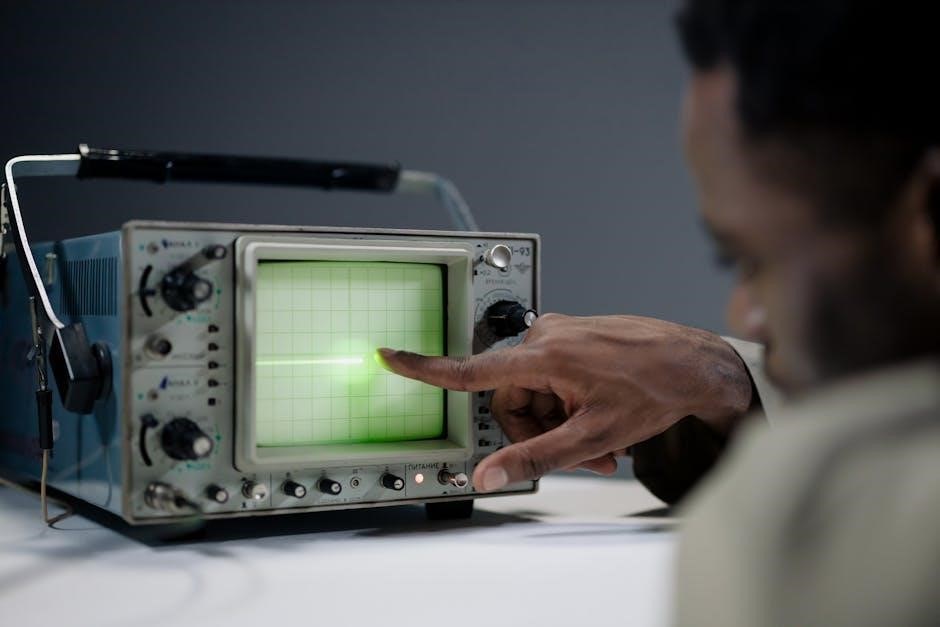Neuropsychological testing is a comprehensive method to evaluate cognitive, emotional, and behavioral functions, providing insights into brain-behavior relationships and aiding in diagnosing neurological or developmental disorders․
1․1 Definition and Purpose
Neuropsychological testing is a scientific method used to evaluate cognitive, emotional, and behavioral functions through standardized tests․ Its primary purpose is to assess brain-behavior relationships, identifying strengths and weaknesses in individuals․ This process helps diagnose neurological or developmental disorders, such as dementia, ADHD, or traumatic brain injury․ By measuring abilities like memory, attention, and problem-solving, neuropsychological testing provides insights into how brain function impacts behavior and overall psychological health․ It is administered by licensed professionals, such as clinical neuropsychologists, to guide accurate diagnoses, monitor progress, and inform rehabilitation strategies․
1․2 Importance in Clinical Practice
Neuropsychological testing plays a crucial role in clinical practice by providing detailed insights into cognitive, emotional, and behavioral functioning․ It aids in diagnosing conditions like dementia, ADHD, and traumatic brain injury, while also assessing the severity of cognitive impairments․ These tests guide differential diagnosis, monitor recovery progress, and inform rehabilitation strategies․ By identifying specific strengths and weaknesses, neuropsychological testing helps clinicians develop targeted interventions․ It is also essential for clinical research, enabling the evaluation of treatment effects and disease progression․ Overall, it is a vital tool for understanding brain function and improving patient outcomes in neurological and psychiatric care settings;
1․3 Overview of Neuropsychological Assessment
A neuropsychological assessment is a comprehensive evaluation of cognitive, emotional, and behavioral functions to understand brain-behavior relationships․ It involves standardized tests, clinical interviews, and behavioral observations to measure abilities such as memory, attention, problem-solving, and language skills․ The goal is to identify how brain function impacts behavior and cognition, aiding in diagnosis, treatment planning, and monitoring progress․ Commonly used in cases of brain injuries, dementia, or developmental disorders, this assessment provides valuable insights into an individual’s psychological and neurological state, guiding clinicians in developing targeted interventions and rehabilitation strategies․

Components of a Neuropsychological Evaluation
A neuropsychological evaluation includes clinical interviews, neuropsychometric tests, behavioral observations, and standardized comparisons to assess cognitive and emotional functions, identifying strengths and weaknesses for accurate diagnosis and treatment planning․
2․1 Clinical Interview
The clinical interview is a foundational component of neuropsychological evaluations, conducted by a licensed neuropsychologist to gather detailed information about a patient’s medical, psychological, and social history․ This session helps identify symptoms, concerns, and relevant background that guide the selection of appropriate neuropsychometric tests․ The interview also assesses the patient’s current mental status, including mood, thought processes, and overall functioning․ Information obtained during the interview is crucial for interpreting test results within the context of the individual’s unique circumstances, ensuring a comprehensive understanding of their cognitive and emotional profile․ This step is essential for developing personalized assessment strategies and rehabilitation plans․

2․2 Neuropsychometric Tests
Neuropsychometric tests are standardized tools used to assess various cognitive functions, such as memory, attention, executive functioning, and problem-solving abilities․ These tests are designed to measure an individual’s performance compared to a normative population, providing insights into strengths and weaknesses․ Administered by licensed professionals, they are essential for diagnosing conditions like traumatic brain injury, dementia, and ADHD․ The results guide treatment planning and monitor progress over time, offering a objective evaluation of cognitive and behavioral changes․ These tests are a cornerstone of neuropsychological evaluations, ensuring accurate and reliable data for clinical decision-making․
2․3 Behavioral Observations
Behavioral observations are a critical component of neuropsychological evaluations, providing insights into an individual’s emotional and cognitive functioning․ Clinicians observe aspects such as attention, mood, and motor skills during testing․ These observations help identify subtle deficits or behavioral patterns that may not emerge through standardized tests alone․ For example, a patient’s ability to follow instructions or exhibit persistence during tasks can offer valuable context․ Such observations, combined with test results, enhance the accuracy of diagnoses and inform personalized treatment plans․ They also help clinicians understand how cognitive impairments manifest in real-world behaviors, ensuring a holistic assessment of an individual’s functioning․
2․4 Standardized Norms and Comparisons
Standardized norms are foundational in neuropsychological testing, enabling comparisons of an individual’s performance to a representative population․ These norms account for demographic factors like age, education, and gender, ensuring test results are interpretable․ By comparing scores to these benchmarks, clinicians identify cognitive strengths and weaknesses, aiding in differential diagnosis․ Standardized comparisons also help monitor progress over time, providing a reliable measure of change․ This approach ensures consistency and validity in assessments, making neuropsychological testing a robust tool for clinical decision-making and research․ Accurate comparisons are essential for developing targeted interventions and understanding an individual’s cognitive profile․

Tools and Techniques in Neuropsychological Testing
Neuropsychological testing employs diverse tools, including test batteries, computerized assessments like CANTAB, the Rorschach Test, and evoked potentials, to evaluate brain function and cognitive processes accurately․
3․1 Neuropsychological Test Batteries
Neuropsychological test batteries are comprehensive sets of assessments designed to evaluate various cognitive functions․ They include tests for memory, attention, executive functions, and language abilities․ These batteries are often used to assess conditions like dementia, traumatic brain injuries, and multiple sclerosis․ Standardized norms allow for comparisons with healthy populations, providing a clear understanding of an individual’s strengths and weaknesses․ Batteries like the Halstead-Reitan and Luria-Nebraska are widely recognized and utilized in clinical settings․ They offer a structured approach to identifying brain-behavior relationships, making them essential tools in neuropsychological evaluations․
3․2 Computerized Neuropsychological Testing (e․g․, CANTAB)
Computerized neuropsychological testing, such as the Cambridge Neuropsychological Test Automated Battery (CANTAB), offers a standardized and efficient way to assess cognitive functions․ These tools measure domains like memory, attention, and executive functions with high precision․ CANTAB is widely used in both research and clinical settings, providing detailed reports on cognitive performance․ Its adaptability makes it suitable for various populations, including children and older adults․ Computerized testing also allows for longitudinal monitoring of recovery and cognitive changes over time, making it invaluable in rehabilitation planning and research on conditions like traumatic brain injury and dementia․
3․3 The Role of the Rorschach Test
The Rorschach test, also known as the inkblot test, is a projective psychological assessment tool used to explore an individual’s personality, emotional functioning, and thought processes․ In neuropsychological testing, it helps identify underlying psychological issues, such as emotional distress or cognitive distortions, which may not be apparent through other tests․ The test involves presenting ambiguous inkblot images and analyzing the participant’s interpretations․ While not a direct measure of cognitive functions, the Rorschach provides complementary insights into the psychological and emotional impact of neurological conditions, enhancing the comprehensive understanding of a patient’s mental state․ Its interpretative nature requires skilled administration and analysis․
3․4 Evoked Potentials (P300 Method)
Evoked potentials, particularly the P300 method, are neurophysiological measures used to assess cognitive processes such as attention and memory․ The P300 is an event-related potential elicited in response to rare or task-relevant stimuli․ It is commonly used in neuropsychological testing to evaluate cognitive dysfunction in conditions like brain injuries or dementia․ The test involves presenting auditory or visual stimuli and measuring the brain’s electrical response․ Its non-invasive nature and ability to provide objective data make it a valuable tool in understanding cognitive deficits and monitoring recovery․ It complements traditional neuropsychological tests by offering insights into neural activity․

Applications of Neuropsychological Testing
Neuropsychological testing is widely applied in diagnosing dementia, assessing traumatic brain injury, evaluating ADHD, and detecting cognitive impairments in conditions like multiple sclerosis․ It aids in clinical decision-making and rehabilitation planning․
4․1 Diagnosis of Dementia
Neuropsychological testing is a critical tool in diagnosing dementia, helping to identify cognitive deficits and differentiate between various types of dementia․ Tests assess memory, language, executive functions, and processing speed, providing insights into the severity and progression of cognitive decline․ By comparing results to standardized norms, clinicians can detect impairments and monitor changes over time․ This approach, combined with patient history and neuroimaging, aids in accurate diagnosis and early detection․ Neuropsychological testing also guides rehabilitation strategies and supports long-term care planning for individuals with dementia․
4․2 Assessment of Traumatic Brain Injury (TBI)
Neuropsychological testing plays a vital role in assessing traumatic brain injuries (TBI) by evaluating cognitive, emotional, and behavioral deficits․ It helps identify impairments in memory, attention, executive functions, and processing speed․ Standardized tests compare results to norms, detecting specific deficits and monitoring recovery over time․ This approach aids in understanding the severity and impact of TBI on daily functioning․ Repeated assessments provide insights into progression and guide rehabilitation strategies, ensuring tailored interventions for individuals with varying degrees of brain injury․
4․3 Evaluation of ADHD
Neuropsychological testing is a valuable tool in evaluating ADHD, focusing on assessing attention, working memory, and executive functioning deficits․ Tests measure cognitive processing speed, impulsivity, and inattention, providing objective data to support diagnosis․ Standardized assessments help differentiate ADHD from other conditions and identify specific cognitive strengths and weaknesses․ Results guide personalized treatment plans, including behavioral strategies and accommodations․ Longitudinal testing tracks progress, ensuring interventions are effective and adapted as needed․ This approach enhances understanding of ADHD’s cognitive and behavioral impacts, aiding in comprehensive management․
4․4 Cognitive Impairment in Multiple Sclerosis (MS)
Neuropsychological testing plays a crucial role in identifying and monitoring cognitive impairment in individuals with Multiple Sclerosis (MS)․ Common deficits include reduced processing speed, memory difficulties, and attentional problems․ Tests such as the Symbol Digit Modalities Test (SDMT) and the Brief Visual Memory Test-Revised (BVMT-R) are commonly used to assess these domains․ Early detection of cognitive impairment allows for timely intervention and tailored rehabilitation strategies․ Longitudinal assessments help track disease progression and evaluate the effectiveness of treatments․ This approach ensures comprehensive management of MS-related cognitive challenges, improving quality of life for affected individuals․

Clinical Utility and Interpretation
Neuropsychological testing provides valuable insights into brain function, guiding clinical decision-making and rehabilitation strategies while aiding in differential diagnosis and monitoring recovery progress in various neurological conditions․
5․1 Strengths and Weaknesses of Neuropsychological Tests
Neuropsychological tests offer precise assessment of cognitive and behavioral functions, aiding in early detection of deficits and guiding interventions․ Their standardized nature ensures reliability across diverse populations․ However, these tests can be time-consuming and may not account for cultural or individual differences, potentially leading to biased results․ Additionally, while they provide comprehensive data, interpretation requires specialized expertise, limiting accessibility for some clinicians․ Despite these limitations, their ability to objectively measure brain function makes them invaluable in clinical and research settings․
5․2 Differential Diagnosis Using Test Results
Neuropsychological test results are instrumental in differentiating between various neurological and psychological conditions․ By analyzing patterns of strengths and weaknesses, clinicians can distinguish conditions like Alzheimer’s disease from frontotemporal dementia or depression․ Standardized norms enable comparisons, highlighting deviations from expected performance․ For instance, memory deficits paired with preserved executive functions may suggest early Alzheimer’s, while impaired executive functions with intact memory could indicate frontotemporal dementia․ These distinctions are critical for accurate diagnoses and tailored interventions․
Test results also help rule out comorbidities, such as ADHD versus other attentional deficits, by identifying specific cognitive profiles․ This precision enhances diagnostic accuracy and informs treatment strategies, making neuropsychological testing a vital tool in clinical practice and research․
5․3 Monitoring Recovery and Progress
Neuropsychological testing plays a crucial role in monitoring recovery and progress, particularly after brain injuries or neurological conditions․ Repeated assessments over time allow clinicians to track changes in cognitive, emotional, and behavioral functions․ This longitudinal approach helps identify improvements, plateaus, or declines, providing valuable insights into the effectiveness of treatments․ For instance, in cases of traumatic brain injury or dementia, regular testing can reveal subtle cognitive enhancements or deteriorations․ Such data informs treatment adjustments and rehabilitation strategies, ensuring personalized and adaptive care․ Monitoring progress also aids in setting realistic goals and evaluating long-term outcomes, making it essential for comprehensive patient management․
5․4 Guiding Rehabilitation Strategies
Neuropsychological testing serves as a cornerstone for guiding rehabilitation strategies by identifying specific cognitive and behavioral deficits․ Test results help tailor interventions to address individual needs, fostering personalized care․ For instance, deficits in memory or attention may prompt targeted therapies․ Progress monitoring through repeated assessments allows clinicians to refine strategies, ensuring optimal outcomes․ Standardized tests provide a baseline, enabling comparisons with pre-injury or pre-illness levels; This data-driven approach ensures rehabilitation plans are adaptive and responsive, addressing evolving patient needs․ Effective use of test results enhances the efficacy of rehabilitation, promoting meaningful recovery and functional improvement․

Specialized Populations and Settings
Neuropsychological testing is adapted for specialized populations, including children, elderly, and individuals with sports-related injuries, ensuring tailored assessments to meet unique needs in diverse clinical settings․
6․1 Pediatric Neuropsychological Assessment
Pediatric neuropsychological assessment focuses on evaluating cognitive, emotional, and behavioral functions in children, addressing developmental disorders, brain injuries, or neurological conditions․ It uses age-appropriate tests to measure abilities like memory, attention, and problem-solving, providing insights into a child’s developmental trajectory․ Early identification of strengths and weaknesses helps guide interventions, improving academic and social outcomes․ Tools like the Cambridge Neuropsychological Test Automated Battery (CANTAB) are adapted for pediatric use, ensuring accurate and reliable results․ This specialized approach requires expertise in child development and neuropsychology, making it a critical tool for supporting children’s overall well-being and future potential․
6․2 Geriatric Neuropsychological Evaluation
Geriatric neuropsychological evaluation focuses on assessing cognitive and emotional functioning in elderly populations, particularly for diagnosing dementia, Alzheimer’s disease, or age-related cognitive decline․ Neuropsychological tests are adapted for older adults to evaluate memory, attention, and executive functions․ Early detection of cognitive impairment enables timely interventions, improving quality of life and managing symptoms effectively․ These evaluations also help differentiate between various types of dementia, guiding targeted care strategies․ Regular monitoring of cognitive changes supports tailored rehabilitation plans, ensuring elderly individuals receive appropriate support and resources for maintaining independence and overall well-being․
6․3 Sports-Related Concussions
Neuropsychological testing plays a critical role in evaluating and managing sports-related concussions, particularly in athletes․ These assessments measure cognitive functions such as memory, attention, and processing speed to identify impairments post-injury․ Tools like the Cambridge Neuropsychological Test Automated Battery (CANTAB) are commonly used for objective evaluations․ Longitudinal studies track recovery patterns, aiding in safe return-to-play decisions․ Such testing helps differentiate between acute and persistent deficits, guiding rehabilitation strategies and reducing the risk of further injury․ Accurate monitoring ensures athletes receive appropriate care, optimizing their recovery and minimizing long-term cognitive sequelae․
6․4 Legal and Forensic Applications
Neuropsychological testing is increasingly utilized in legal and forensic contexts to assess cognitive and behavioral impairments related to brain injury or neurological conditions․ These evaluations provide objective data to support claims of diminished capacity, memory loss, or emotional distress․ In court cases, neuropsychological test results are often admitted as evidence to establish the extent of impairment․ Neuropsychologists may testify as expert witnesses, offering insights into how brain function impacts behavior and decision-making․ This application ensures fair legal outcomes by providing a scientific basis for understanding an individual’s mental state, particularly in cases involving trauma, dementia, or developmental disorders․

Advances and Innovations in Neuropsychological Testing
Advances in neuropsychological testing include remote assessments, integration with neuroimaging, and cultural adaptations․ These innovations enhance accessibility, accuracy, and applicability across diverse populations and settings․
7․1 Remote Neuropsychological Testing During COVID-19
The COVID-19 pandemic accelerated the adoption of remote neuropsychological testing, ensuring continuity of care while minimizing infection risks․ Digital platforms and telehealth tools enabled clinicians to administer tests securely, maintaining patient engagement and data accuracy․ This shift demonstrated the feasibility of remote assessments, particularly for monitoring cognitive changes and diagnosing conditions like dementia․ Studies confirmed that remote testing could effectively discriminate between different types of dementia, showcasing its utility in longitudinal research․ Additionally, remote methods proved adaptable for diverse populations, including those in pediatric and geriatric settings, ensuring equitable access to neuropsychological evaluations during the pandemic․
7․2 Longitudinal Studies in Sports-Related Injuries
Longitudinal studies in sports-related injuries have become crucial for tracking cognitive recovery and understanding the long-term effects of concussions․ Neuropsychological testing plays a key role in monitoring athletes’ progress, particularly after mild traumatic brain injuries (mTBI)․ Tools like the Cambridge Neuropsychological Test Automated Battery (CANTAB) have been utilized to assess executive functions and cognitive impairment in pediatric and adult populations․ These studies highlight the importance of repeated assessments to identify patterns of recovery and persistent deficits․ Such research informs rehabilitation strategies and return-to-play decisions, ensuring safer outcomes for athletes․ The data also aids in developing standardized protocols for managing sports-related brain injuries․
7․3 Integration of Neuroimaging Techniques
The integration of neuroimaging techniques, such as functional MRI (fMRI) and diffusion tensor imaging (DTI), with neuropsychological testing has revolutionized the assessment of brain function and structure․ These technologies provide a more comprehensive understanding of cognitive and behavioral deficits by identifying specific brain regions affected by injury or disease․ For instance, fMRI can reveal areas of reduced activity correlating with impaired performance on neuropsychological tests․ This combined approach enhances diagnostic accuracy and enables clinicians to monitor neurological recovery more effectively․ The fusion of imaging and testing data also aids in developing targeted rehabilitation strategies and improves outcomes for patients with brain-related conditions․
7․4 Cultural Adaptations of Neuropsychological Tests
Cultural adaptations of neuropsychological tests ensure equitable assessment across diverse populations․ Standardized tests are often developed in Western contexts, limiting their applicability to non-Western cultures․ Adaptations involve translating tests, modifying content, and validating norms for different cultural groups․ This ensures fairness and accuracy in measuring cognitive abilities․ For example, tests like CANTAB have been adapted for use in pediatric populations worldwide․ Cultural sensitivity is crucial for avoiding bias and ensuring reliable results․ These adaptations enhance the validity of neuropsychological assessments in multicultural settings, promoting better diagnostic accuracy and rehabilitation outcomes for diverse patient groups․

Training and Professional Development
Training involves graduate education, certification, and continuous learning to stay updated on advancements․ Ethical considerations, interdisciplinary collaboration, and professional development opportunities are emphasized․
8․1 Education and Certification for Neuropsychologists
Education for neuropsychologists typically involves graduate-level training in clinical psychology with a focus on neuropsychology․ Programs include coursework, supervised training, and internships․ Certification is often required, ensuring expertise in administering and interpreting neuropsychological tests․ Professionals must stay updated on advancements through continuous learning․ Ethical considerations and standardized testing practices are emphasized․ Certification ensures neuropsychologists are qualified to assess cognitive, emotional, and behavioral functions accurately․ This specialized training enables them to use tools like CANTAB and Rorschach effectively, providing reliable evaluations for clinical and research purposes․
8․2 Continuous Learning in Neuropsychological Assessment
Continuous learning is essential for neuropsychologists to stay updated on advancements in assessment techniques and tools․ Professionals engage in workshops, conferences, and ongoing education to refine their skills․ Staying current with scientific literature and emerging technologies ensures accurate and effective test administration․ Integration of new tools, like CANTAB, enhances assessment capabilities․ Collaboration with interdisciplinary teams fosters a deeper understanding of cognitive and behavioral functioning․ Lifelong learning ensures neuropsychologists remain competent in evaluating complex neurological conditions, providing reliable and evidence-based evaluations for clinical and research purposes․ This commitment to growth maintains high standards in neuropsychological practice․
8․3 Ethical Considerations in Test Administration
Ethical considerations in neuropsychological testing are crucial to ensure integrity and fairness․ Confidentiality must be maintained to protect patient privacy․ Informed consent is essential, ensuring individuals understand the purpose and procedures of testing․ Tests must be administered without bias, and cultural sensitivity is vital to avoid misinterpretation․ Additionally, test security is paramount to prevent unauthorized access or misuse․ Ethical guidelines also emphasize the importance of avoiding conflicts of interest and ensuring that results are interpreted accurately and without prejudice․ Adherence to these principles ensures that neuropsychological assessments are conducted responsibly and respectfully․
8․4 Interdisciplinary Collaboration in Neuropsychology
Interdisciplinary collaboration is vital in neuropsychology, ensuring comprehensive care for patients with complex conditions․ Neuropsychologists work alongside neurologists, psychiatrists, and rehabilitation specialists to integrate test results with medical data․ This teamwork enhances diagnostic accuracy and treatment planning․ Collaboration also promotes a holistic understanding of cognitive, emotional, and behavioral deficits, leading to more effective interventions․ Additionally, sharing insights with educators and occupational therapists supports tailored strategies for patients in educational and vocational settings․ Such collaboration fosters a cohesive approach, addressing the multifaceted needs of individuals with neurological or developmental challenges, ultimately improving outcomes and quality of life․

Resources and References
Key resources include textbooks like Neuropsychological Assessment by M․ Lezak and Clinicians Guide to Neuropsychological Assessment․ Online repositories offer access to tests like CANTAB, while journals such as Neuropsychologia provide cutting-edge research․
9․1 Recommended Textbooks on Neuropsychological Assessment
Essential textbooks include Neuropsychological Assessment by M․ Lezak, offering a detailed guide to assessment principles and practices․ The Clinicians Guide to Neuropsychological Assessment provides practical insights for professionals․ Compendium of Neuropsychological Tests is a comprehensive resource covering test strengths, weaknesses, and applications․ These texts are invaluable for both students and practitioners, ensuring a strong foundation in neuropsychological evaluation and interpretation․ They are widely referenced in clinical and academic settings, making them indispensable tools for understanding neuropsychological assessment methodologies․
9․2 Online Repositories for Neuropsychological Testing
Online repositories provide accessible resources for neuropsychological testing materials and guidelines․ The Cambridge Neuropsychological Test Automated Battery (CANTAB) is a notable example, offering digital assessments for cognitive functions․ Websites like ResearchGate and academic databases host numerous PDFs, such as the MarkVCID Evaluators Instructions Manual, which guide test administration․ Additionally, platforms like biaia․org offer downloadable resources for clinical applications․ These repositories are invaluable for researchers and clinicians, ensuring access to standardized tools and updated methodologies for neuropsychological evaluation and research purposes․
9․3 Key Journals in the Field of Neuropsychology
Key journals in neuropsychology provide essential insights into advancements, research, and methodologies․ Neuropsychologia focuses on brain-behavior relationships, while the Journal of the International Neuropsychological Society highlights clinical and experimental studies․ The Clinical Neuropsychologist offers practical applications for assessments․ These journals often feature downloadable PDFs of studies, reviews, and case analyses, serving as vital resources for researchers and clinicians․ They cover diverse topics, including cognitive impairments, traumatic brain injuries, and neurodevelopmental disorders, ensuring access to cutting-edge knowledge in the field of neuropsychological testing and evaluation․
9․4 Professional Organizations and Guidelines
Professional organizations play a crucial role in shaping standards for neuropsychological testing․ The International Neuropsychological Society (INS) and the National Academy of Neuropsychology (NAN) are key entities that establish ethical guidelines and best practices․ These organizations provide resources, including training manuals and updated protocols, to ensure reliable and culturally sensitive assessments․ They also promote evidence-based interventions and continuous professional development․ By adhering to these guidelines, neuropsychologists maintain high standards of practice, ensuring accurate and effective evaluations․ These resources are often available as downloadable PDFs, offering accessible learning tools for professionals in the field․
10․2 Future Directions in Neuropsychological Testing
Future advancements in neuropsychological testing include integrating neuroimaging, enhancing remote assessments, and developing culturally adapted tools to improve accessibility and accuracy in cognitive evaluations globally․
10․1 Summary of Key Points
Neuropsychological testing is a critical tool for assessing cognitive, emotional, and behavioral functions, aiding in the diagnosis and management of neurological and developmental disorders․ It evaluates memory, attention, executive functions, and more, providing insights into brain-behavior relationships․ Standardized tests, administered by professionals, compare individual performance to norms, identifying strengths and weaknesses․ Clinical applications include diagnosing dementia, TBI, ADHD, and MS, while guiding rehabilitation strategies․ Advances like remote testing, neuroimaging integration, and cultural adaptations are expanding its utility․ This comprehensive approach supports accurate diagnoses, monitors recovery, and informs personalized interventions across diverse populations and settings․
Future advancements in neuropsychological testing include integrating AI and machine learning for personalized assessments, enhancing remote testing accessibility, and incorporating neuroimaging for a more holistic evaluation․ Cultural adaptations of tests will ensure equitable assessment across diverse populations․ Longitudinal studies, particularly in sports-related injuries, will provide deeper insights into cognitive recovery․ Ethical considerations and continuous professional development will remain critical as these innovations evolve․ These directions aim to improve accuracy, accessibility, and applicability of neuropsychological testing, ensuring better outcomes for individuals with neurological or developmental conditions․
